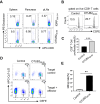Immunopeptidome mining reveals a novel ERS-induced target in T1D
- PMID: 38689020
- PMCID: PMC11143349
- DOI: 10.1038/s41423-024-01150-0
Immunopeptidome mining reveals a novel ERS-induced target in T1D
Abstract
Autoreactive CD8+ T cells play a key role in type 1 diabetes (T1D), but the antigen spectrum that activates autoreactive CD8+ T cells remains unclear. Endoplasmic reticulum stress (ERS) has been implicated in β-cell autoantigen generation. Here, we analyzed the major histocompatibility complex class I (MHC-I)-associated immunopeptidome (MIP) of islet β-cells under steady and ERS conditions and found that ERS reshaped the MIP of β-cells and promoted the MHC-I presentation of a panel of conventional self-peptides. Among them, OTUB258-66 showed immunodominance, and the corresponding autoreactive CD8+ T cells were diabetogenic in nonobese diabetic (NOD) mice. High glucose intake upregulated pancreatic OTUB2 expression and amplified the OTUB258-66-specific CD8+ T-cell response in NOD mice. Repeated OTUB258-66 administration significantly reduced the incidence of T1D in NOD mice. Interestingly, peripheral blood mononuclear cells (PBMCs) from patients with T1D, but not from healthy controls, showed a positive IFN-γ response to human OTUB2 peptides. This study provides not only a new explanation for the role of ERS in promoting β-cell-targeted autoimmunity but also a potential target for the prevention and treatment of T1D. The data are available via ProteomeXchange with the identifier PXD041227.
Keywords: CD8+ T cells; ERS; OTUB2; T1D; immunopeptidome.
© 2024. The Author(s), under exclusive licence to CSI and USTC.
Conflict of interest statement
The authors declare no competing interests. Yuzhang Wu is an editorial board member of
Figures








Similar articles
-
Proteomic identification of MHC class I-associated peptidome derived from non-obese diabetic mouse thymus and pancreas.J Proteomics. 2023 Jan 6;270:104746. doi: 10.1016/j.jprot.2022.104746. Epub 2022 Oct 7. J Proteomics. 2023. PMID: 36210013
-
Insulin-degrading enzyme regulates insulin-directed cellular autoimmunity in murine type 1 diabetes.Front Immunol. 2024 Nov 12;15:1474453. doi: 10.3389/fimmu.2024.1474453. eCollection 2024. Front Immunol. 2024. PMID: 39600694 Free PMC article.
-
Selective delivery of beta cell antigen to dendritic cells in vivo leads to deletion and tolerance of autoreactive CD8+ T cells in NOD mice.Proc Natl Acad Sci U S A. 2008 Apr 29;105(17):6374-9. doi: 10.1073/pnas.0802644105. Epub 2008 Apr 22. Proc Natl Acad Sci U S A. 2008. PMID: 18430797 Free PMC article.
-
The good turned ugly: immunopathogenic basis for diabetogenic CD8+ T cells in NOD mice.Immunol Rev. 2005 Apr;204:250-63. doi: 10.1111/j.0105-2896.2005.00244.x. Immunol Rev. 2005. PMID: 15790363 Review.
-
Bridging Mice to Men: Using HLA Transgenic Mice to Enhance the Future Prediction and Prevention of Autoimmune Type 1 Diabetes in Humans.Methods Mol Biol. 2016;1438:137-51. doi: 10.1007/978-1-4939-3661-8_9. Methods Mol Biol. 2016. PMID: 27150089 Review.
Cited by
-
Unveiling the Disparities in the Field of Precision Medicine: A Perspective.Health Sci Rep. 2025 Jul 27;8(8):e71102. doi: 10.1002/hsr2.71102. eCollection 2025 Aug. Health Sci Rep. 2025. PMID: 40735262 Free PMC article.
-
Endoplasmic Reticulum-Targeted Phototherapy Remodels the Tumor Immunopeptidome to Enhance Immunogenic Cell Death and Adaptive Anti-Tumor Immunity.Pharmaceuticals (Basel). 2025 Mar 28;18(4):491. doi: 10.3390/ph18040491. Pharmaceuticals (Basel). 2025. PMID: 40283929 Free PMC article.
References
-
- De Riva A, Varley MC, Bluck LJ, Cooke A, Deery MJ, Busch R. Accelerated turnover of MHC class II molecules in nonobese diabetic mice is developmentally and environmentally regulated in vivo and dispensable for autoimmunity. J Immunol. 2013;190:5961–71. doi: 10.4049/jimmunol.1300551. - DOI - PMC - PubMed
MeSH terms
Substances
Grants and funding
LinkOut - more resources
Full Text Sources
Medical
Molecular Biology Databases
Research Materials

